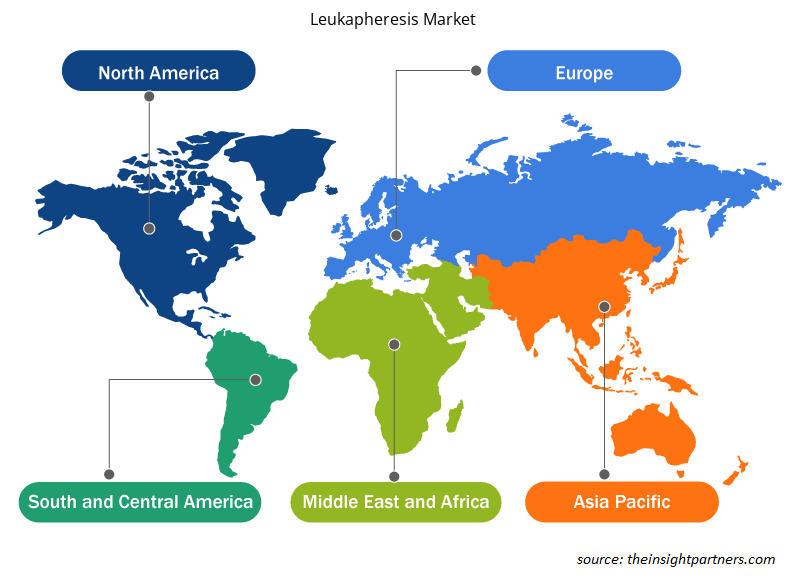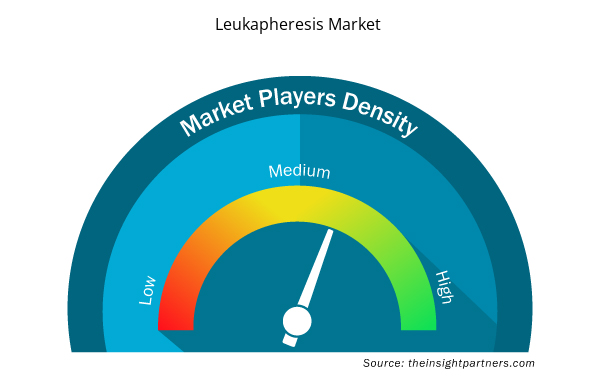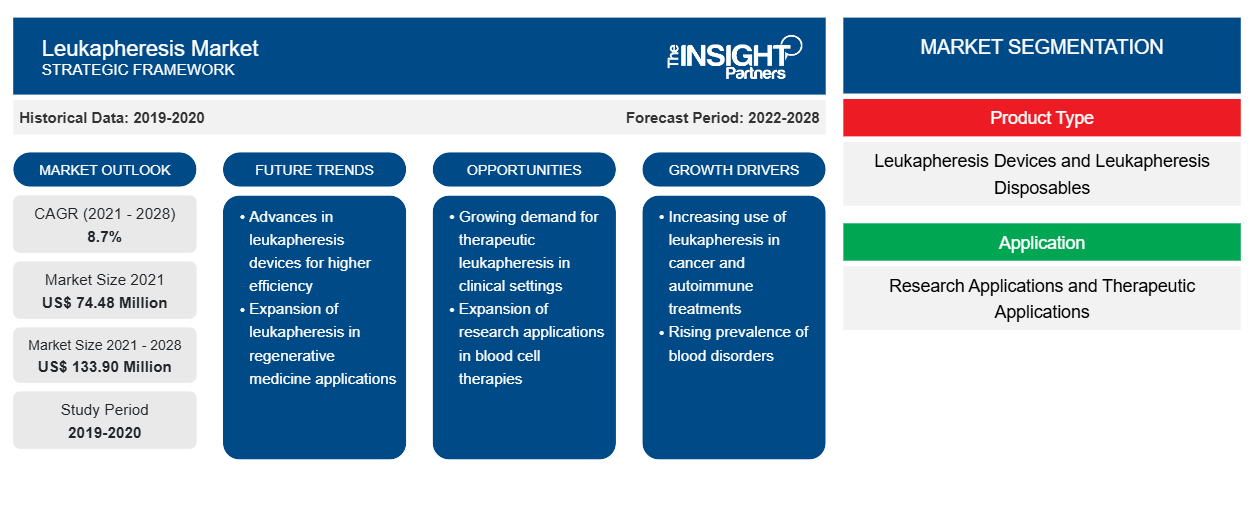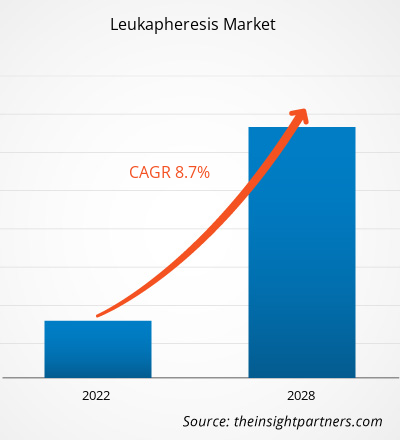[연구 보고서] 백혈구채취술 시장은 2021년 7,448만 달러에서 2028년까지 1억 3,390만 달러에 도달할 것으로 예상되며, 2021년에서 2028년까지 연평균 성장률 8.7%로 성장할 것으로 추산됩니다.
백혈구채취술은 신체의 면역 반응에 관여하는 백혈구(백혈구)를 혈액 샘플에서 분리하는 시술입니다. 적혈구나 혈소판과 같은 혈액의 일부를 채취하고 나머지 혈액을 순환계로 되돌리는 특정 형태의 채혈술입니다. 백혈구채취술은 만성 림프구성 백혈병(CLL)과 같은 만성 혈액암과 같이 매우 높은 백혈구(WBC) 수치를 줄이는 데 자주 사용됩니다. 또한, 항암 화학 요법 중에 백혈구 수치가 갑자기 감소하는 것을 관리하는 것과 같이 나중에 이식할 백혈구를 채취하기 위해 수행할 수도 있습니다. 또 다른 용도는 백혈병, 전립선암 및 기타 형태의 암과 싸우는 데 도움이 되는 키메라 항원 수용체(CAR) T 세포 요법이라는 새로운 형태의 면역 요법의 일부로 사용하는 것입니다. 백혈구채취술은 치료를 청구하는 사람(자가 채혈술) 또는 나중에 이식을 위해 기증자(이종이식 채혈술)에게 수행할 수 있습니다. 현재 백혈구채취술은 다양한 질병을 치료하는 데 일반적으로 사용되고 있으며, 순환 종양 세포 수율을 높일 수 있기 때문에 진단 목적으로도 사용됩니다. 자발적인 헌혈자 수의 증가, 혈액 질환의 발병률 증가, 노인 인구의 급증과 같은 요인이 백혈구채취술 시장 성장을 촉진하고 있습니다. 그러나 백혈구채취술의 높은 비용은 어느 정도 시장 성장을 방해합니다.
귀하의 요구 사항에 맞게 이 보고서를 사용자 정의하세요
이 보고서의 일부 또는 국가 수준 분석, Excel 데이터 팩을 포함하여 모든 보고서에 대한 사용자 정의를 무료로 받을 수 있으며 신생 기업 및 대학을 위한 훌륭한 혜택과 할인 혜택을 이용할 수 있습니다.
- 이 보고서의 주요 시장 동향을 알아보세요.이 무료 샘플에는 시장 동향부터 추정 및 예측까지 다양한 데이터 분석이 포함됩니다.
시장 통찰력
수혈은 다양한 국가의 국가적 건강 인프라와 정책의 필수적인 부분입니다. 의료 산업의 발전으로 심각한 질병과 부상의 치료 절차가 개선되었고, 결국 환자의 생존을 위해 수혈이 필요하게 되었습니다. 의료 서비스에서 수혈과 혈액 가용성의 중요성에 대한 인식이 커지면서 의학적 목적으로 혈액을 기증하려는 사람들의 수가 증가했습니다. 세계보건기구(WHO) 데이터에 따르면 2018년 전 세계적으로 약 1억 1,740만 건의 헌혈이 보고되었습니다. 헌혈자는 일반적으로 자발적 무급, 유료, 가족/대체로 분류되며 WHO 주장에 따르면 자발적/무급 기증자는 안정적이고 적절한 혈액 공급의 주요 공급원입니다. 2019년 WHO 데이터에 따르면 자발적 무급 기증자의 헌혈은 전 세계 139개국에서 2008년부터 2015년까지 1,160만 건 증가했습니다. 헌혈 추세는 저소득 및 중소득 국가에서도 상당한 주목을 받고 있습니다. 2017년 CAG 연례 회의에서 제시된 데이터에 따르면, 2016년에 1,087명의 환자에게 약 13,000건의 시술이 수행되었습니다. 자발적 헌혈자 수의 가장 큰 급증은 동남아시아 국가(83%)와 아메리카(70%)에서 발견되었습니다.
많은 국가에서 개발되고 도입된 국가 프로그램은 많은 수의 혈소판 및 혈액 기증자를 더욱 끌어들이고 있습니다. 예를 들어, 인도에서는 국가 에이즈 통제 기구(NACO) 내에 구성된 국가 혈액 수혈 위원회(NBTC)가 국가 에이즈 통제 협회(SACS) 내에 설립된 국가 혈액 수혈 위원회(SBTC)와 협력하는 중앙 기관입니다. NBTC는 혈액 수혈 서비스(BTS)와 관련된 다양한 활동을 위한 건강 프로그램을 지원합니다. 따라서 전 세계 여러 국가에서 적격 기증자가 증가함에 따라 필요한 혈액 성분을 분리하는 데 사용되는 백혈구채혈 장비에 대한 필요성이 커지고 있습니다.
제품 유형 기반 통찰력
제품 유형에 따라 백혈구채취 시장은 백혈구채취 장치와 백혈구채취 일회용품으로 나뉩니다. 2021년에는 백혈구채취 일회용품 부문이 더 큰 시장 점유율을 차지했습니다. 그러나 백혈구채취 장치 부문은 2021년에서 2028년 사이에 더 높은 CAGR을 기록할 것으로 예상됩니다.
애플리케이션 기반 통찰력
백혈구채취 시장은 응용 분야별로 다음과 같이 나뉩니다.연구 응용 및 치료 응용. 2021년에 연구 응용 분야 부문은 시장 점유율이 더 높았고, 같은 부문은 향후 몇 년 동안 더 높은 CAGR을 기록할 것으로 예상됩니다.
최종 사용자 기반 통찰력
백혈구채취 시장은 최종 사용자별로 제약 및 생명공학 회사, 학술 및 연구 기관, 혈액 성분 공급자 및 혈액 센터, 병원 및 수혈 센터로 세분화됩니다. 2021년에 혈액 성분 공급자 및 혈액 센터 부문이 시장에서 가장 큰 점유율을 차지했습니다. 반면에 병원 및 수혈 센터 부문은 향후 몇 년 동안 가장 높은 CAGR을 기록할 것으로 예상됩니다.
백혈구채집술 시장에서 활동하는 회사들은 제품 출시, 합병 및 인수, 협력, 제품 혁신, 제품 포트폴리오 확장과 같은 전략을 채택하여 전 세계적으로 입지를 확대하고, 브랜드를 유지하며, 최종 사용자의 증가하는 수요를 충족하고 있습니다.
백혈구채취 시장 지역 통찰력
Insight Partners의 분석가들은 예측 기간 동안 백혈구채취술 시장에 영향을 미치는 지역적 추세와 요인을 철저히 설명했습니다. 이 섹션에서는 북미, 유럽, 아시아 태평양, 중동 및 아프리카, 남미 및 중미의 백혈구채취술 시장 세그먼트와 지리에 대해서도 설명합니다.

- 백혈구채취술 시장에 대한 지역별 데이터 얻기
백혈구채취 시장 보고서 범위
| 보고서 속성 | 세부 |
|---|---|
| 2021년 시장 규모 | 7448만 달러 |
| 2028년까지 시장 규모 | 1억 3,390만 달러 |
| 글로벌 CAGR (2021-2028) | 8.7% |
| 역사적 데이터 | 2019-2020 |
| 예측 기간 | 2022-2028 |
| 다루는 세그먼트 | 제품 유형별
|
| 포함된 지역 및 국가 | 북아메리카
|
| 시장 선도 기업 및 주요 회사 프로필 |
|
백혈구채취 시장 참여자 밀도: 비즈니스 역학에 미치는 영향 이해
백혈구채취 시장 시장은 소비자 선호도의 변화, 기술 발전, 제품의 이점에 대한 인식 증가와 같은 요인으로 인해 최종 사용자 수요가 증가함에 따라 빠르게 성장하고 있습니다. 수요가 증가함에 따라 기업은 제품을 확장하고, 소비자의 요구를 충족하기 위해 혁신하고, 새로운 트렌드를 활용하여 시장 성장을 더욱 촉진하고 있습니다.
시장 참여자 밀도는 특정 시장이나 산업 내에서 운영되는 회사나 기업의 분포를 말합니다. 주어진 시장 공간에 얼마나 많은 경쟁자(시장 참여자)가 존재하는지 그 규모나 전체 시장 가치에 비해 나타냅니다.
백혈구채취술 시장에서 활동하는 주요 회사는 다음과 같습니다.
- 아사히카세이 주식회사
- 프레세니우스 SE & Co. KGaA
- 헤모네틱스 코퍼레이션
- 테루모 주식회사
- 스템셀 테크놀로지 주식회사
면책 조항 : 위에 나열된 회사는 어떤 특별한 순서에 따라 순위가 매겨지지 않았습니다.

- 백혈구채취술 시장 주요 주요 업체 개요를 알아보세요
백혈구채취 시장 – 제품 유형별
- 백혈구채취 장치
- 체외채혈 장치
- 백혈구채취 컬럼 및 세포 분리기
- 백혈구 감소 필터
- 백혈구채취 일회용품
백혈구채취 시장 – 응용 프로그램별
- 연구 응용 프로그램
- 치료적 응용 프로그램
백혈구채취 시장 – 최종 사용자별
- 제약 및 생명공학 회사
- 학술 및 연구 기관
- 혈액 성분 공급자 및 혈액 센터
- 병원 및 수혈 센터
백혈구채취 시장 – 지리별
북아메리카
- 우리를
- 캐나다
- 멕시코
유럽
- 프랑스
- 독일
- 이탈리아
- 영국
- 스페인
- 유럽의 나머지 지역
아시아 태평양(APAC)
- 중국
- 인도
- 대한민국
- 일본
- 호주
- 아시아 태평양의 나머지 지역
중동 및 아프리카(MEA)
- 남아프리카 공화국
- 사우디 아라비아
- 아랍에미리트
- 중동 및 아프리카의 나머지 지역
남미(SAM)
- 브라질
- 아르헨티나
- 남미와 중미의 나머지 지역
회사 프로필
- 아사히카세이 주식회사
- 프레세니우스 SE & Co. KGaA
- 헤모네틱스 코퍼레이션
- 테루모 주식회사
- 스템셀 테크놀로지 주식회사
- 헤마케어
- 마코파마
- 올셀스
- 스템익스프레스
- 바이오IVT
- 역사적 분석(2년), 기준 연도, CAGR을 포함한 예측(7년)
- PEST 및 SWOT 분석
- 시장 규모 가치/양 - 글로벌, 지역, 국가
- 산업 및 경쟁 환경
- Excel 데이터 세트



Report Coverage
Revenue forecast, Company Analysis, Industry landscape, Growth factors, and Trends

Segment Covered
This text is related
to segments covered.

Regional Scope
North America, Europe, Asia Pacific, Middle East & Africa, South & Central America

Country Scope
This text is related
to country scope.
자주 묻는 질문
The leukapheresis market majorly consists of the players such Asahi Kasei Corporation, Fresenius SE & Co. KGaA, Haemonetics Corporation Terumo Corporation, STEMCELL Technologies Inc., HemaCare, Macopharma, AllCells, STEMEXPRESS, and BioIVT amongst others.
Global leukapheresis market is segmented by region into North America, Europe, Asia Pacific, Middle East & Africa, and South & Central America. In North America, the U.S. is the largest market for leukapheresis. The growth of the region is attributed to increasing product launches coupled with increasing patient population.
The Asia Pacific region is expected to account for the fastest growth in the leukapheresis market. Increase in government investments and a number of private biotechnology companies in this region contribute to this dominant share. The rising geriatric population and increasing investment in research are said to be responsible for this growth.
The leukapheresis disposables segment dominated the global leukapheresis market and held the largest revenue share of 61.43% in 2021.
The blood component providers and blood centers segment dominated the global leukapheresis market and accounted for the largest revenue share of 35.03% in 2021.
Key factors that are driving the growth of this market are number of voluntary blood donors, increasing incidence of hematologic diseases, surge in elderly population and growing demand for leukopaks in clinical research activities boost the market growth over the years.
Leukapheresis is a procedure that has white blood cells (leukocytes) involved in the body's immune response are segregated from a blood sample. It is a particular form of apheresis in which an element of blood, such as red blood cells or platelets, is obtained while the remaining blood is restored to circulation. Leukapheresis is often used to reduce very high white blood cell (WBC) counts, such as chronic blood cancers like chronic lymphocytic leukemia (CLL). It can also be completed to obtain white blood cells for later transplant, such as to manage abrupt declines in WBC counts throughout cancer chemotherapy. Another use is as a section of a novel form of immunotherapy, termed chimeric antigen receptor (CAR) T-cell therapy, to help fight leukemia, prostate cancer, and other forms of cancers. Leukapheresis can be completed on the person claiming treatment (autologous apheresis) or on a donor for a later transplant (allogeneic apheresis). Currently, leukapheresis is commonly used to treat various diseases, and it is also used for diagnostic purposes as it can increase circulating tumor cells yields.
Trends and growth analysis reports related to Life Sciences : READ MORE..
The List of Companies - Leukapheresis Market
- Asahi Kasei Corporation
- Fresenius SE & Co. KGaA
- Haemonetics Corporation
- Terumo Corporation
- STEMCELL Technologies Inc.
- HemaCare
- Macopharma
- AllCells
- STEMEXPRESS
- BioIVT
The Insight Partners performs research in 4 major stages: Data Collection & Secondary Research, Primary Research, Data Analysis and Data Triangulation & Final Review.
- Data Collection and Secondary Research:
As a market research and consulting firm operating from a decade, we have published and advised several client across the globe. First step for any study will start with an assessment of currently available data and insights from existing reports. Further, historical and current market information is collected from Investor Presentations, Annual Reports, SEC Filings, etc., and other information related to company’s performance and market positioning are gathered from Paid Databases (Factiva, Hoovers, and Reuters) and various other publications available in public domain.
Several associations trade associates, technical forums, institutes, societies and organization are accessed to gain technical as well as market related insights through their publications such as research papers, blogs and press releases related to the studies are referred to get cues about the market. Further, white papers, journals, magazines, and other news articles published in last 3 years are scrutinized and analyzed to understand the current market trends.
- Primary Research:
The primarily interview analysis comprise of data obtained from industry participants interview and answers to survey questions gathered by in-house primary team.
For primary research, interviews are conducted with industry experts/CEOs/Marketing Managers/VPs/Subject Matter Experts from both demand and supply side to get a 360-degree view of the market. The primary team conducts several interviews based on the complexity of the markets to understand the various market trends and dynamics which makes research more credible and precise.
A typical research interview fulfils the following functions:
- Provides first-hand information on the market size, market trends, growth trends, competitive landscape, and outlook
- Validates and strengthens in-house secondary research findings
- Develops the analysis team’s expertise and market understanding
Primary research involves email interactions and telephone interviews for each market, category, segment, and sub-segment across geographies. The participants who typically take part in such a process include, but are not limited to:
- Industry participants: VPs, business development managers, market intelligence managers and national sales managers
- Outside experts: Valuation experts, research analysts and key opinion leaders specializing in the electronics and semiconductor industry.
Below is the breakup of our primary respondents by company, designation, and region:

Once we receive the confirmation from primary research sources or primary respondents, we finalize the base year market estimation and forecast the data as per the macroeconomic and microeconomic factors assessed during data collection.
- Data Analysis:
Once data is validated through both secondary as well as primary respondents, we finalize the market estimations by hypothesis formulation and factor analysis at regional and country level.
- Macro-Economic Factor Analysis:
We analyse macroeconomic indicators such the gross domestic product (GDP), increase in the demand for goods and services across industries, technological advancement, regional economic growth, governmental policies, the influence of COVID-19, PEST analysis, and other aspects. This analysis aids in setting benchmarks for various nations/regions and approximating market splits. Additionally, the general trend of the aforementioned components aid in determining the market's development possibilities.
- Country Level Data:
Various factors that are especially aligned to the country are taken into account to determine the market size for a certain area and country, including the presence of vendors, such as headquarters and offices, the country's GDP, demand patterns, and industry growth. To comprehend the market dynamics for the nation, a number of growth variables, inhibitors, application areas, and current market trends are researched. The aforementioned elements aid in determining the country's overall market's growth potential.
- Company Profile:
The “Table of Contents” is formulated by listing and analyzing more than 25 - 30 companies operating in the market ecosystem across geographies. However, we profile only 10 companies as a standard practice in our syndicate reports. These 10 companies comprise leading, emerging, and regional players. Nonetheless, our analysis is not restricted to the 10 listed companies, we also analyze other companies present in the market to develop a holistic view and understand the prevailing trends. The “Company Profiles” section in the report covers key facts, business description, products & services, financial information, SWOT analysis, and key developments. The financial information presented is extracted from the annual reports and official documents of the publicly listed companies. Upon collecting the information for the sections of respective companies, we verify them via various primary sources and then compile the data in respective company profiles. The company level information helps us in deriving the base number as well as in forecasting the market size.
- Developing Base Number:
Aggregation of sales statistics (2020-2022) and macro-economic factor, and other secondary and primary research insights are utilized to arrive at base number and related market shares for 2022. The data gaps are identified in this step and relevant market data is analyzed, collected from paid primary interviews or databases. On finalizing the base year market size, forecasts are developed on the basis of macro-economic, industry and market growth factors and company level analysis.
- Data Triangulation and Final Review:
The market findings and base year market size calculations are validated from supply as well as demand side. Demand side validations are based on macro-economic factor analysis and benchmarks for respective regions and countries. In case of supply side validations, revenues of major companies are estimated (in case not available) based on industry benchmark, approximate number of employees, product portfolio, and primary interviews revenues are gathered. Further revenue from target product/service segment is assessed to avoid overshooting of market statistics. In case of heavy deviations between supply and demand side values, all thes steps are repeated to achieve synchronization.
We follow an iterative model, wherein we share our research findings with Subject Matter Experts (SME’s) and Key Opinion Leaders (KOLs) until consensus view of the market is not formulated – this model negates any drastic deviation in the opinions of experts. Only validated and universally acceptable research findings are quoted in our reports.
We have important check points that we use to validate our research findings – which we call – data triangulation, where we validate the information, we generate from secondary sources with primary interviews and then we re-validate with our internal data bases and Subject matter experts. This comprehensive model enables us to deliver high quality, reliable data in shortest possible time.


 이 보고서에 대한 무료 샘플을 받으세요
이 보고서에 대한 무료 샘플을 받으세요